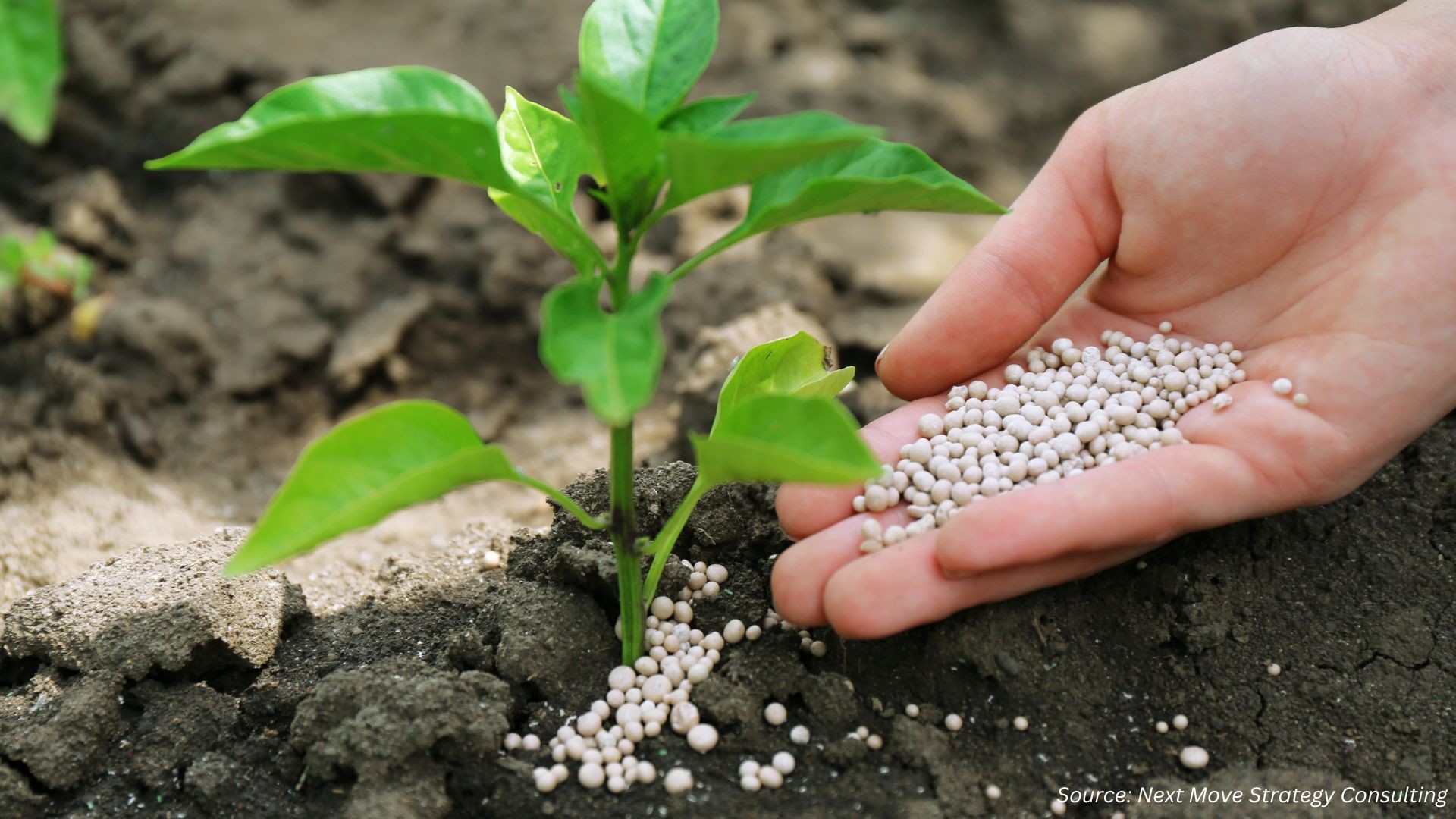Fertilizer Additives Market: How Are Innovations and Regulations Driving Sustainable Agriculture?
Published: 2025-09-19

The fertilizer additives market is undergoing a transformation as sustainability and efficiency become central to global agricultural policies. Recent scientific breakthroughs and regulatory reforms are redefining how fertilizers are developed, applied, and monitored. From innovative plant-based nitrogen inhibitors to government-backed amendments for biostimulants, the industry is aligning with long-term environmental and productivity goals.
Eco-Friendly Fertilizer Additive Marks Breakthrough in Nitrogen Management
A research team from the Institute of Applied Ecology at the Chinese Academy of Sciences has created a sustainable fertilizer additive that boosts crop yields while simultaneously cutting emissions of harmful gases.
Breakthrough in Sustainable Agriculture: Plant-Based Fertilizer Additive Enhances Nitrogen Efficiency
A recent study published in Soil & Tillage Research highlights a significant advancement in sustainable agriculture and soil nitrogen management. The research introduces 2-cyclopenten-1-one (CCO), a plant-derived compound that acts as a dual-action nitrogen inhibitor. By slowing the transformation and loss of nitrogen in soil, CCO enhances nitrogen use efficiency and supports higher crop productivity.
Unlike traditional inhibitors such as NBPT (N-butylthiophosphoric triamide) and DMPP (3,4-dimethylpyrazole phosphate)—which are hindered by issues like rapid degradation, high production costs, and ecological risks—CCO provides a more sustainable and potentially more effective solution for long-term agricultural use.
Key Highlights:
-
Researchers at the Institute of Applied Ecology, Chinese Academy of Sciences, have developed a sustainable fertilizer additive that increases crop yields while reducing harmful gas emissions.
-
The additive, 2-cyclopenten-1-one (CCO), is a plant-derived compound functioning as a dual-action nitrogen inhibitor, improving nitrogen use efficiency by slowing nitrogen transformation and loss in soil.
-
Unlike conventional inhibitors such as NBPT and DMPP, CCO offers a greener, more cost-effective, and longer-lasting alternative, addressing issues of rapid degradation and ecological concerns.
Fertilizer Amendment 2025: Advancing Sustainable Farming with Biostimulant Regulations
The Ministry of Agriculture and Farmers Welfare has announced a major amendment to the Fertilizer (Inorganic, Organic, or Mixed) (Control) Order, 1985, designed to boost crop productivity and promote sustainable farming. Known as the Fertilizer (Inorganic, Organic, or Mixed) (Control) Fourth Amendment Order, 2025, the revised framework establishes detailed regulations for biostimulants, microbial formulations, and biochemical fertilizers.
New Specifications for Biostimulants Under Fertilizer Amendment 2025
A major highlight of the amendment is the inclusion of detailed standards for humic acid, fulvic acid, and seaweed-based biostimulants, providing clear guidelines on their composition, permissible ingredients, and crop-specific dosages. For instance, humic acid 6% (liquid) is now required to contain at least 6% potassium humate derived from Leonardite. Similarly, humic-fulvic acid 76% (powder) must maintain a precise balance of humic and fulvic acids, supported by stabilizers such as dextrose monohydrate.
The order also specifies application methods tailored to different crops—for example, foliar sprays of 1.25 liters per hectare for tomatoes and soil applications of 30 kilograms per hectare for chillies—ensuring both effectiveness and safety in agricultural use.
New Standards for Biostimulants
The amendment specifies precise formulations for humic acid, fulvic acid, and seaweed-based biostimulants. For instance:
|
Biostimulant Type |
Requirement |
Crop Application Example |
|
Humic Acid 6% (liquid) |
≥6% potassium humate (Leonardite-based) |
Foliar spray: 1.25 L/ha for tomatoes |
|
Humic-Fulvic Acid 76% (powder) |
Balanced humic and fulvic acids with stabilizers (e.g., dextrose monohydrate) |
Soil application: 30 kg/ha for chillies |
Strengthened Quality Control Measures for Microbial Biostimulants
To uphold consistency and effectiveness, the amendment introduces strict tolerance limits for microbial counts in biostimulants. For example, Methylococcus capsulatus must contain no less than 5 × 10^7 CFU/g, while consortia of Methylobacterium species are required to maintain 2.5 × 10^6 CFU/g per strain. These regulations are designed to standardize the efficacy of microbial formulations and encourage the adoption of eco-friendly alternatives to conventional chemical fertilizers.
Key Highlights:
-
The Fertilizer (Inorganic, Organic, or Mixed) (Control) Fourth Amendment Order, 2025 introduces comprehensive rules for biostimulants, microbial formulations, and biochemical fertilizers to enhance crop productivity and sustainability.
-
Detailed standards for humic acid, fulvic acid, and seaweed-based biostimulants specify composition, permissible ingredients, and precise crop-based dosages, including foliar sprays for tomatoes and soil applications for chillies.
-
New quality control measures mandate microbial count thresholds, such as 5 × 10^7 CFU/g for Methylococcus capsulatus and 2.5 × 10^6 CFU/g per strain for Methylobacterium consortia, ensuring efficacy and eco-friendly alternatives to chemical fertilizers.
Market Impact of Innovations and Regulatory Reforms in Fertilizer Additives
The fertilizer additives market is poised for substantial transformation as both scientific innovations and regulatory reforms converge to promote sustainability, efficiency, and environmental responsibility. The introduction of plant-based nitrogen inhibitors and government-backed amendments for biostimulants is expected to shape market demand, competitiveness, and long-term growth trajectories.
Positive Market Impacts: Driving Growth and Sustainability
The latest breakthroughs and policies are likely to generate significant positive momentum in the fertilizer additives market. By addressing long-standing challenges associated with nitrogen use efficiency and inconsistent biostimulant standards, these initiatives open doors for innovation, investment, and broader adoption.
Key Positive Impacts:
-
Boost to Sustainable Agriculture: Plant-derived inhibitors like CCO (2-cyclopenten-1-one) offer greener and more efficient alternatives to conventional additives, aligning with the global push for eco-friendly farming practices.
-
Regulatory Clarity and Standardization: The Fertilizer Amendment 2025 establishes precise specifications for biostimulants, reducing market confusion and encouraging farmers to adopt regulated products with proven efficacy.
-
Improved Crop Productivity: Enhanced nitrogen efficiency and regulated biostimulant usage will directly support higher yields, contributing to food security and agricultural profitability.
-
Increased Investment Opportunities: Standardized regulations lower risks for manufacturers and investors, accelerating product development and market entry of innovative additives.
-
Global Competitiveness: Countries adopting sustainable fertilizer technologies early will gain a competitive edge in agricultural exports by meeting stricter international sustainability benchmarks.
Potential Negative Market Impacts: Challenges and Adjustments
While the reforms and innovations carry clear benefits, the market could also face short-term disruptions and cost-related hurdles. Transitioning from traditional inhibitors and unregulated formulations to advanced, regulated solutions may create resistance among some stakeholders.
Key Negative Impacts:
-
Higher Compliance Costs: Meeting the stringent specifications outlined in the Fertilizer Amendment 2025 could increase manufacturing costs for producers, especially smaller players.
-
Market Adjustment Period: Farmers accustomed to conventional fertilizers and additives may face a learning curve in adopting new products and dosage requirements.
-
Supply Chain Realignment: Manufacturers will need to adapt production and distribution systems to meet new standards, potentially causing short-term disruptions.
-
Uncertainty in Adoption Rates: Despite their long-term benefits, plant-based inhibitors like CCO may face slower adoption due to limited awareness, availability, or initial pricing concerns.
-
Regulatory Pressure on Imports: Imported biostimulants and microbial formulations may face stricter scrutiny under the new framework, potentially restricting foreign suppliers and increasing reliance on domestic production.
Overall Outlook: Balanced but Growth-Oriented
The overall market outlook remains strongly positive, as the long-term benefits of sustainability, efficiency, and regulatory clarity are expected to outweigh the short-term challenges of compliance and adoption. Over the next decade, the fertilizer additives market is likely to experience accelerated innovation, rising global demand for eco-friendly products, and strengthened confidence among farmers and investors.
Next Steps: Actionable Insights for Stakeholders
-
Farmers: Explore adoption of CCO-based fertilizer additives to improve nitrogen efficiency and reduce costs.
-
Policymakers: Consider aligning national standards with India’s regulatory model for biostimulants to promote uniform sustainability practices.
-
Industry Leaders: Invest in research and development of plant-based additives to stay ahead in a competitive, eco-conscious market.
-
Researchers: Expand long-term field studies on CCO and similar compounds to establish region-specific application strategies.
-
Agri-Tech Startups: Develop monitoring tools to help farmers apply new biostimulants and additives with precision.
Conclusion
The fertilizer additives market is entering a new era defined by innovation and regulation. Plant-based solutions like CCO and India’s Fertilizer Amendment 2025 illustrate how science and policy can work together to promote sustainable farming. While short-term challenges exist in compliance and adoption, the long-term opportunities for higher yields, eco-friendly practices, and global competitiveness make this transformation both necessary and promising for the future of agriculture.
About the Author
 Karabi Sonowal is an experienced SEO Executive and Content Writer in digital marketing. She excels in SEO, content creation, and data-driven strategies that boost online visibility and engagement. Known for simplifying complex concepts, Karabi creates impactful content aligned with industry trends.
Karabi Sonowal is an experienced SEO Executive and Content Writer in digital marketing. She excels in SEO, content creation, and data-driven strategies that boost online visibility and engagement. Known for simplifying complex concepts, Karabi creates impactful content aligned with industry trends.
About the Reviewer
 Debashree Dey is a skilled Content Writer, PR Specialist, and Assistant Manager with expertise in digital marketing. She creates impactful, data-driven campaigns and audience-focused content to boost brand visibility. Passionate about creativity, she also draws inspiration from design and innovative projects.
Debashree Dey is a skilled Content Writer, PR Specialist, and Assistant Manager with expertise in digital marketing. She creates impactful, data-driven campaigns and audience-focused content to boost brand visibility. Passionate about creativity, she also draws inspiration from design and innovative projects.















Add Comment